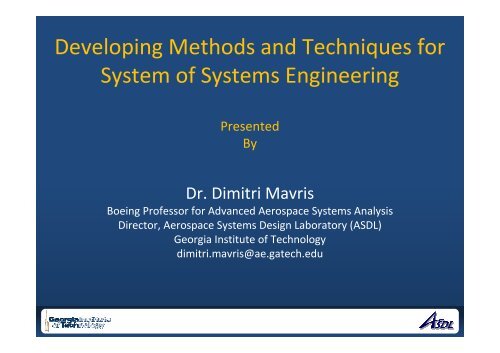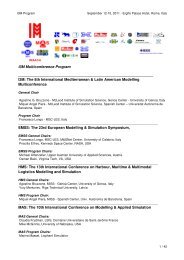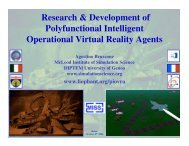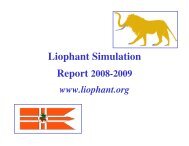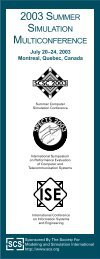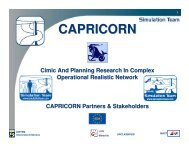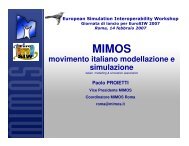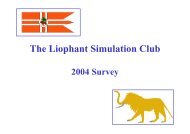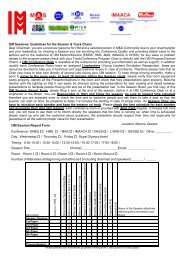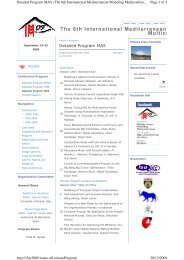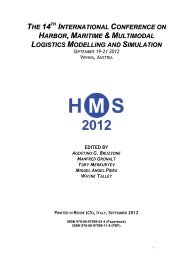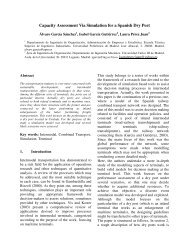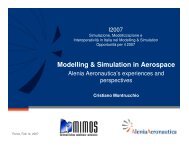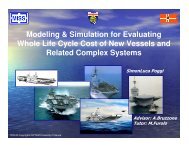System-of-Systems Engineering - Liophant Simulation
System-of-Systems Engineering - Liophant Simulation
System-of-Systems Engineering - Liophant Simulation
You also want an ePaper? Increase the reach of your titles
YUMPU automatically turns print PDFs into web optimized ePapers that Google loves.
Developing Methods and Techniques for<strong>System</strong> <strong>of</strong> <strong>System</strong>s <strong>Engineering</strong>PresentedByDr. Dimitri MavrisBoeing Pr<strong>of</strong>essor for Advanced Aerospace <strong>System</strong>s AnalysisDirector, Aerospace <strong>System</strong>s Design Laboratory (ASDL)Georgia Institute <strong>of</strong> Technologydimitri.mavris@ae.gatech.edu
Outline• Motivation• What is a SoS, and what is SoSE?• Challenges in SoSE• Enabling Techniques and Methods• Research Areas• ConclusionsDeveloping Methods and Techniques for <strong>System</strong> <strong>of</strong> <strong>System</strong>s <strong>Engineering</strong>Dr. Dimitri Mavris, dimitri.mavris@ae.gatech.edu2
The Aerospace <strong>System</strong>s Design Laboratory• Founded in 1992, ASDL was created to bridge thegap between academia and industry’s researchperspectives– 175 MS and PhD Students, 50 Undergrads, 40 ResearchStaff Members and over $14M in sponsored research• School <strong>of</strong> AE was one <strong>of</strong> the seven originalGuggenheim Aeronautics schools, founded in 1930• GT consistently ranked 3rd or 4th best college <strong>of</strong>engineering in the country based on US News &World Report* Aerospace, Transportation & Advanced <strong>System</strong>s LaboratoryDeveloping Methods and Techniques for <strong>System</strong> <strong>of</strong> <strong>System</strong>s <strong>Engineering</strong>Dr. Dimitri Mavris, dimitri.mavris@ae.gatech.edu3
Motivation - Increasing need for moreinteroperable, cost-effective systems• Military systems are becomingincreasingly complex as informationand communications technology surges• Distribution <strong>of</strong> operations is creating aneed for aerospace systems to becomeincreasingly interoperablehttps://nasea.faa.gov/architecture/main/display/2• Despite their complexity, aerospacesystems must be cost effectiveThese trends have resulted in an increasedfocus on <strong>System</strong>-<strong>of</strong>-<strong>System</strong>s <strong>Engineering</strong> incivil, military, and space applicationsDeveloping Methods and Techniques for <strong>System</strong> <strong>of</strong> <strong>System</strong>s <strong>Engineering</strong>Dr. Dimitri Mavris, dimitri.mavris@ae.gatech.edu4http://www.ibm.com
Motivation- Emphasis on “Early-Phase” SE• <strong>System</strong>s <strong>Engineering</strong> (SE)– An interdisciplinary approach to derive, evolve, and verify a life-cycle balancedsystem solution that satisfies customer expectations and meets publicacceptability (IEEE 1220-1994)• The most fundamental (and most difficult and costly to reverse) decisionsare made in the early phases <strong>of</strong> design and architecture definition– This is doubly true for <strong>System</strong> <strong>of</strong> <strong>System</strong>sVerification andValidation“Early-Phase” SEAdapted From INCOSE HandbookDeveloping Methods and Techniques for <strong>System</strong> <strong>of</strong> <strong>System</strong>s <strong>Engineering</strong>Dr. Dimitri Mavris, dimitri.mavris@ae.gatech.edu5
Shift to a “Capability-based” Focus“In the past 15 years, the Department <strong>of</strong> Defense (DOD) has faced a constant stream<strong>of</strong> new challenges…the United States must be prepared both to deal with a largernumber <strong>of</strong> more diverse threats with varied attributes and to do so in circumstancesinvolving complex and uncertain risks.”-Naval Analytical Capabilities: Improving Capabilities-Based Planning, Committee on Naval Analytical Capabilities andImproving Capabilities-Based Planning, National Research Council• There is an overall desire to acquire capabilities, particularly in military applications– New acquisition paradigms attempt to be more “top-down” and avoid stove-piping• These capabilities are <strong>of</strong>ten not enabled by a single system, but rather by a system<strong>of</strong> systems– The supporting systems (such as ships and aircraft) are typically multi-mission– <strong>System</strong>s cannot be studied in isolation, but must be examined in the context <strong>of</strong>operational scenarios, environments, and interactions• High-quality <strong>System</strong> <strong>of</strong> <strong>System</strong>s <strong>Engineering</strong> is a key component to successfulcapability-based designDeveloping Methods and Techniques for <strong>System</strong> <strong>of</strong> <strong>System</strong>s <strong>Engineering</strong>Dr. Dimitri Mavris, dimitri.mavris@ae.gatech.edu6
What is a system?“A set <strong>of</strong> functional elements organized to satisfy user needs.” (IEEE P1220 p. 238)Developing Methods and Techniques for <strong>System</strong> <strong>of</strong> <strong>System</strong>s <strong>Engineering</strong>7Dr. Dimitri Mavris, dimitri.mavris@ae.gatech.edu7
What is a <strong>System</strong> <strong>of</strong> <strong>System</strong>s?Developing Methods and Techniques for <strong>System</strong> <strong>of</strong> <strong>System</strong>s <strong>Engineering</strong>Dr. Dimitri Mavris, dimitri.mavris@ae.gatech.edu8
<strong>System</strong> <strong>of</strong> <strong>System</strong>s• “A set or arrangement <strong>of</strong> systems that results when independentand useful systems are integrated into a larger system thatdelivers unique capabilities.”– DoD Defense Acquisition Guidebook 2004• "<strong>System</strong> <strong>of</strong> systems applies to a system-<strong>of</strong>-interest whose systemelements are themselves systems; typically these entail largescale inter-disciplinary problems with multiple, heterogeneous,distributed systems."– INCOSE-TP-2003-002-03, <strong>System</strong>s <strong>Engineering</strong> Handbook V3• “Groups <strong>of</strong> systems, each <strong>of</strong> which individually provides its ownmission capability, that can be operated collectively to achieve anindependent, and usually larger, common mission capability “– Pre-Milestone A and Early-Phase <strong>System</strong>s <strong>Engineering</strong>: A Retrospective Review and Benefits for FutureAir Force <strong>System</strong>s Acquisition. National Academies Press, 2008Developing Methods and Techniques for <strong>System</strong> <strong>of</strong> <strong>System</strong>s <strong>Engineering</strong>Dr. Dimitri Mavris, dimitri.mavris@ae.gatech.edu9
What makes <strong>System</strong>s <strong>of</strong> <strong>System</strong>s (SoS)Different?• Compared to a <strong>System</strong>, an SoS might:– Be larger in scope– Have more complex integration– Usually be subject to higher degree <strong>of</strong> uncertainty and risk– Evolve more continuously with elements <strong>of</strong> differing lifecycles– Lack a single management/acquisition entity and have abroader range <strong>of</strong> stakeholders– Have elements which are not designed to fit the whole, andwhich are integrated post-design and deployment– Exhibit emergent behaviors– Have more ambiguous requirements and fuzzy boundaries– Have continuous SE which is never finished<strong>System</strong>-<strong>of</strong>-<strong>System</strong>s <strong>Engineering</strong> is an emerging discipline in the aerospace communityand new methods and techniques are required to address SoS challenges, but theseshould be based on proven <strong>System</strong>s <strong>Engineering</strong> methodsDeveloping Methods and Techniques for <strong>System</strong> <strong>of</strong> <strong>System</strong>s <strong>Engineering</strong>Dr. Dimitri Mavris, dimitri.mavris@ae.gatech.eduSources: INCOSE SE Handbook v3, "Architecting Principles for <strong>System</strong>s-<strong>of</strong>-<strong>System</strong>s“ by Mark W. Maier, DoD SE Guide for SoS10
What is SoSE?• <strong>System</strong> <strong>of</strong> <strong>System</strong>s (SoS) <strong>Engineering</strong> is an emerginginterdisciplinary approach focusing on the effort required totransform capabilities into SoS solutions and shape therequirements for systems. SoS <strong>Engineering</strong> ensures that:– Individually developed, managed, and operated systems function asautonomous constituents <strong>of</strong> one or more SoS and provide appropriatefunctional capabilities to each <strong>of</strong> those SoS– Political, financial, legal, technical, social, operational, andorganizational factors, including the stakeholders’ perspectives andrelationships, are considered in SoS development, management, andoperations– A SoS can accommodate changes to its conceptual, functional,physical, and temporal boundaries without negative impacts on itsmanagement and operations– A SoS collective behavior, and its dynamic interactions with itsenvironment to adapt and respond, enables the SoS to meet orexceed the required capability.Source: <strong>System</strong> <strong>of</strong> <strong>System</strong>s <strong>Engineering</strong> Center <strong>of</strong> Excellence, Sponsored by the Office <strong>of</strong> the Under Secretary <strong>of</strong> Defense for Acquisition,Technology, & Logistics, Defense <strong>System</strong>s, <strong>System</strong>s and Mission Integration, Joint Force Integration (USD-AT&L)Developing Methods and Techniques for <strong>System</strong> <strong>of</strong> <strong>System</strong>s <strong>Engineering</strong>Dr. Dimitri Mavris, dimitri.mavris@ae.gatech.edu11
INCOSE Challenges in SoS <strong>Engineering</strong>1. Complexity is a major issue2. Management can overshadow engineering3. The initial requirements are likely to be ambiguous4. <strong>System</strong> elements operate independently5. Fuzzy boundaries cause confusion6. <strong>System</strong> elements have different life cycles7. SoS engineering is never finishedNew methods and techniques are required to address these challengesDeveloping Methods and Techniques for <strong>System</strong> <strong>of</strong> <strong>System</strong>s <strong>Engineering</strong>Dr. Dimitri Mavris, dimitri.mavris@ae.gatech.edu12
The Evolution <strong>of</strong> New Ideas“All truth passes through three stages. First, it isridiculed. Second, it is violently opposed. Third, it isaccepted as being self-evident.”--Arthur Schopenhauer, German philosopher (1788 - 1860)This principle is observed for all new ideas as wellDeveloping Methods and Techniques for <strong>System</strong> <strong>of</strong> <strong>System</strong>s <strong>Engineering</strong>Dr. Dimitri Mavris, dimitri.mavris@ae.gatech.edu13
Overcoming Organizational Barriers associatedwith any new Methodology• New methods go against the grain <strong>of</strong> established paradigms that are welldefined and accepted by the practicing community and thus are alwaysviewed with skepticism, criticism, or cynicism• Criteria to facilitate the introduction and acceptance <strong>of</strong> new methods :– The underlying theories, methods, mathematics, logic, algorithms, etc. uponwhich the new approaches are based must be well understood, accepted,scientifically sound and practical– Familiarity is needed with the underlying theories and the material needed forsomeone to understand the method itself must be readily available– Availability <strong>of</strong> training material written on the overarching method, tutorials,etc. with relevant examples– Tools automating the proposed method and making it practical for every dayuse to take the method beyond the academic level– Relevant examples and applications within a given field <strong>of</strong> study• Proposed methods which are grounded in or are complimentary toestablished practices have a better chance <strong>of</strong> succeedingDeveloping Methods and Techniques for <strong>System</strong> <strong>of</strong> <strong>System</strong>s <strong>Engineering</strong>Dr. Dimitri Mavris, dimitri.mavris@ae.gatech.edu14
What is needed for this New Paradigm Shift to Occur?• Transition from single-discipline to multi-disciplinary analysis, design and optimizationthat can handle concurrently means and ways trades• Easy to use integrative environments that can handle the combinatorial nature <strong>of</strong> theSOS problems• Automation <strong>of</strong> the resultant integrated design process• Transition from a reliance on historical data to physics-based formulations, especiallytrue for unconventional concepts• Means to perform requirements exploration, technology infusion trade-<strong>of</strong>fs andconcept down selections during the early design phases (conceptual design) usingphysics-based methods• Methods which will allow us to move from deterministic, serial, single-point solutionsto dynamic parametric trade environments• Incorporation <strong>of</strong> probabilistic methods to quantify, assess risk• Transition from single-objective to multi-objective optimization• Need to speed up computation to allow for the inclusion <strong>of</strong> variable fidelity tools so asto improve accuracy, from macro-level to meso- to micro-level representations• Means to facilitate data and knowledge creation, storage, versioning, retrieval andmining• An integrated knowledge based systems engineering and management framework• Means to perform dynamic visualization <strong>of</strong> the results in a team-centered, real-timeanalysis environmentDeveloping Methods and Techniques for <strong>System</strong> <strong>of</strong> <strong>System</strong>s <strong>Engineering</strong>Dr. Dimitri Mavris, dimitri.mavris@ae.gatech.edu15
Synthesis <strong>of</strong> Established Techniques to Create New MethodsDeveloping Methods and Techniques for <strong>System</strong> <strong>of</strong> <strong>System</strong>s <strong>Engineering</strong>Dr. Dimitri Mavris, dimitri.mavris@ae.gatech.edu16
An Architecture-based Approach to SoSE• “The initial stages <strong>of</strong> architecture design are where the most fundamental design decisionsare made; these are the decisions which are most difficult to correct when they are in error”– Felix Bachmann, S<strong>of</strong>tware <strong>Engineering</strong> Institute (SEI) at Carnegie Melon• “To effectively acquire complex systems-<strong>of</strong>-systems in a capability-based acquisitionenvironment requires that we increase the use <strong>of</strong> integrated architectures to identify interrelationshipsand resolve issues with system integration and interoperability that impact theoperational effectiveness <strong>of</strong> warriors; platforms; command and control; networks; andweapons.”– Phillipp Charles, Chief Engineer <strong>of</strong> SPAWAR <strong>System</strong>s Center• “Degradation in combat effectiveness can be caused by…poor or non-existent integration orinteroperability. Because integration and interoperability are so critical to combateffectiveness, the entire Family <strong>of</strong> <strong>System</strong>s must be considered in the engineering andacquisition process if decision makers are to choose the most operationally sound, technicallyfeasible, and effective program investments”– Dickerson, Soules, Sabins, Charles in “Using Architectures for Research Development andAcquisition”Developing Methods and Techniques for <strong>System</strong> <strong>of</strong> <strong>System</strong>s <strong>Engineering</strong>Dr. Dimitri Mavris, dimitri.mavris@ae.gatech.edu17
ArchitectureHistorically:• The art or practice <strong>of</strong> designing and constructing buildings (Oxford English Dictionary)• Formation or construction resulting from or as if from a conscious act resulting in a unifyingor coherent form or structure (Merriam-Webster Dictionary)• Many others• Common Themes: Structure, Utility, Beauty (or attractiveness)In <strong>System</strong>s <strong>Engineering</strong>:• The fundamental organization <strong>of</strong> a system, embodied in its components, their relationshipsto each other and the environment, and the principles governing its design and evolution.(From ANSI/IEEE 1471-2000)At ASDL:• The fundamental organization <strong>of</strong> a system, embodied in its components, their relationshipsto each other and the environment, the principles governing its design and evolution, itspurpose (utility), and its attractiveness (e.g. functionality, cost, etc)Including the utility and the value into the architecture development phase requires the ability toestimate and evaluate these components <strong>of</strong> the architecture, thus driving a need for architectureframeworks to be integrated with systems engineering and modeling and simulationDeveloping Methods and Techniques for <strong>System</strong> <strong>of</strong> <strong>System</strong>s <strong>Engineering</strong>Dr. Dimitri Mavris, dimitri.mavris@ae.gatech.edu18
The <strong>System</strong> Alternative Space• The Interactive Reconfigurable Matrix <strong>of</strong> Alternatives (IRMA) isused to explore the alternative space for a new system• The IRMA is demonstrated here using a notional exampleDeveloping Methods and Techniques for <strong>System</strong> <strong>of</strong> <strong>System</strong>s <strong>Engineering</strong>Dr. Dimitri Mavris, dimitri.mavris@ae.gatech.edu19
SoS Architecture Alternative Space• Operational Alternatives (HOW and WHEN)– Changing the ways things are done (for example, thecommunication structure, or the order in which activities areperformed)• <strong>System</strong> Alternatives (WHAT and HOW MANY)– Changing the elements (physical systems, the means) <strong>of</strong> thearchitecture• Organizational Alternatives (WHO)– Changing who is responsible for certain elements, activities,facilities, etc• Network Alternatives (HOW)– Changing the network architecture that enables the informationflow required by the SoS• Combinations <strong>of</strong> the aboveDeveloping Methods and Techniques for <strong>System</strong> <strong>of</strong> <strong>System</strong>s <strong>Engineering</strong>Dr. Dimitri Mavris, dimitri.mavris@ae.gatech.edu20
The Architecture-based Technology Evaluation andCapability Trade<strong>of</strong>f Method (ARCHITECT)Capability: The ability to achieve an effect to astandard in a given environment using multiplecombinations <strong>of</strong> ways and means (DoD)WAYSMEANSDeveloping Methods and Techniques for <strong>System</strong> <strong>of</strong> <strong>System</strong>s <strong>Engineering</strong>Dr. Dimitri Mavris, dimitri.mavris@ae.gatech.edu21
Modeling and <strong>Simulation</strong> Challenges in SoS <strong>Engineering</strong>• Physical experiments are typically infeasible or limited– Computer simulations are required, and are <strong>of</strong>tencomputationally intensive and time consuming– Verification and Validation is a challenge• SoS are complex– Limits available modeling techniques– Often results in high dimensionality• SoS have a large and diverse alternative space– Unfathomable number <strong>of</strong> combinations– Need to speed up modeling and simulation– Can be challenging to visualize results• SoS are stochastic in nature– For a given set <strong>of</strong> inputs, the results are a distribution– Behavior is <strong>of</strong>ten modal in natureDeveloping Methods and Techniques for <strong>System</strong> <strong>of</strong> <strong>System</strong>s <strong>Engineering</strong>Dr. Dimitri Mavris, dimitri.mavris@ae.gatech.edu22
Extension to <strong>System</strong>s-<strong>of</strong>-<strong>System</strong>s Analysis• The DoD shift to capabilitybasedacquisition is mergingthe operations research andsystems design communities• The impact <strong>of</strong> systems andsub-systems is <strong>of</strong>tennegligible when compared totactics, doctrine, and strategy• Methods for efficientscenario construction,surrogate creation, andoptimization for SoS areneededInfinite FOR FixedTarget SensorGIT Battle ManagerIn-TheaterBasingTarget Latitude373635AirborneSensorLRS PlatformsHigh Speed Missile34Baghdad33323130Denied Basing39 40 41 42 43 44 45 46 47 48Target LongitudeDistribution <strong>of</strong> Successful Engagementsin Iraq (Desert Storm Scenario)Perfect CommunicationsJDAM-likeLow Speed MissileDefensesThrust/Weight Ratio1.51.41.31.21.110.90.80.70.60.50.40.3TCT Finder/ShooterTCT’sIADSSuccessful Engagements20 30 40 50 60 70 80 90 100 110 120 130 140 150Wing Loading (lb/ft 2 )Successful Engagements Favor HighWing Loading and Low Thrust/WeightRatio (Bomber-like)AreaDominance(Multi-Hit)High ValueTargets(Fixed)TargetBomberDead SAMsBattle ManagerMap Image c/o National Geospatial Intelligence Agency (www.nga.mil)Targets NeutralizedHigh SpeedLess SuccessfulPlatform SpeedBest Speed~ 750 knotsMunition RangeThe Complexity <strong>of</strong> the <strong>System</strong>s-<strong>of</strong>-<strong>System</strong>s Analysis Problem Often Confounds AnalystsDeveloping Methods and Techniques for <strong>System</strong> <strong>of</strong> <strong>System</strong>s <strong>Engineering</strong>Dr. Dimitri Mavris, dimitri.mavris@ae.gatech.edu23
What Is Meant By a Complex <strong>System</strong>?• Many contrasting views– Biology, Computer Science, <strong>Engineering</strong>, Economics, etc.• Complex <strong>System</strong>: two pertinent definitions– A system composed <strong>of</strong> interconnected parts that as a whole exhibit one or more properties(behavior among the possible properties) not obvious from the properties <strong>of</strong> the individualparts 1 (Reductionism vs. Holism)– A system having many interrelated, interconnected, or interwoven elements and interfaces 2Physical DomainSimple ComplexSimple<strong>System</strong>Very Predictable.Traditionalengineeringmethods apply.Chaotic<strong>System</strong>(Non-Deterministic)Randomperturbations giveappearance <strong>of</strong>complexity. Solvedusing Robust DesignComplicated<strong>System</strong>Satisfies functionalrequirements, butcannot ensureunder all possibleconditions/ statesComplex<strong>System</strong>Must architectsystem to behavecorrectly bytailoring theemergentbehaviorsFigure adapted from Balestrini-Robinson, Santiago. “A Modeling Process toUnderstand Complex <strong>System</strong> Architectures,” 2009.Functional DomainSimple ComplexDeveloping Methods and Techniques for <strong>System</strong> <strong>of</strong> <strong>System</strong>s <strong>Engineering</strong>Dr. Dimitri Mavris, dimitri.mavris@ae.gatech.edu Architecture 3 :Structure <strong>of</strong> componentsRelationships (Complexinformation exchanges, systeminterfaces, functionalinteroperation, etc.)Principles & guidelinesgoverning evolution over time1. Joslyn, C. and Rocha, L. (2000). Towards Semiotic Agent-Based Models<strong>of</strong> Socio-Technical Organizations, 2000.2. Crawley, Edward. <strong>System</strong> Architecture –course notes. MIT, 2005.243. IEEE Std 610.12
Fundamental Properties <strong>of</strong> a Complex <strong>System</strong>1. Self Organization2. Non-LinearInteractions3. Adaptation4. HeterogeneityEmergentBehaviorComplex system properties lead to emergent behaviorDeveloping Methods and Techniques for <strong>System</strong> <strong>of</strong> <strong>System</strong>s <strong>Engineering</strong>Dr. Dimitri Mavris, dimitri.mavris@ae.gatech.edu25
Impact <strong>of</strong> Complexity on Modeling and <strong>Simulation</strong>• Self Organization– Feedback and interactions must be captured• Non-Linearity– Behavior is more than sum <strong>of</strong> the behavior <strong>of</strong> the components– Tiny change in a condition can eventually lead to a huge number<strong>of</strong> different possible results• Adaptation– Complex systems continually adapt to their environment toimprove performance– Adaptive agents are more robust but more difficult to create• Heterogeneity– Chance <strong>of</strong> emulating emergent behavior increases with moreinteractions <strong>of</strong> diverse agentsDeveloping Methods and Techniques for <strong>System</strong> <strong>of</strong> <strong>System</strong>s <strong>Engineering</strong>Dr. Dimitri Mavris, dimitri.mavris@ae.gatech.edu26
Enablers for Complex SoS• Design <strong>of</strong> Computer<strong>Simulation</strong>s– Space Filling Designs– Adaptive DoE• Modeling and <strong>Simulation</strong>Techniques– Agent-based modeling andconstructive simulations– <strong>System</strong> Dynamics Modeling– Discrete Event <strong>Simulation</strong>– Mathematical Modeling Techniques• Non-linear SurrogateModeling– Neural Networks– Kriging/Gaussian– Stepwise RSE• Probabilistic Theory– Stochastic modeling– Surrogate modeling <strong>of</strong> stochasticprocesses– Monte Carlo <strong>Simulation</strong>• Visual AnalyticsDeveloping Methods and Techniques for <strong>System</strong> <strong>of</strong> <strong>System</strong>s <strong>Engineering</strong>Dr. Dimitri Mavris, dimitri.mavris@ae.gatech.edu27
Enablers for Complex SoS• Design <strong>of</strong> Computer<strong>Simulation</strong>s– Space Filling Designs– Adaptive DoE• Modeling and <strong>Simulation</strong>Techniques– Agent-based modeling andconstructive simulations– <strong>System</strong> Dynamics Modeling– Discrete Event <strong>Simulation</strong>– Mathematical Modeling Techniques• Non-linear SurrogateModeling– Neural Networks– Kriging/Gaussian– Stepwise RSE• Probabilistic Theory– Stochastic modeling– Surrogate modeling <strong>of</strong> stochasticprocesses– Monte Carlo <strong>Simulation</strong>• Visual AnalyticsDeveloping Methods and Techniques for <strong>System</strong> <strong>of</strong> <strong>System</strong>s <strong>Engineering</strong>Dr. Dimitri Mavris, dimitri.mavris@ae.gatech.edu28
Design <strong>of</strong> Experiments• Design <strong>of</strong> Experiments (DoE) was developedfor physical experiments– Effect <strong>of</strong> fertilizers on crops– Effect <strong>of</strong> food and environment on bacteriagrowth– Variations in weld strengths• Design <strong>of</strong> Experiments has historically focusedon how to devise screening techniques andsampling strategies for physical experimentsthat are aimed at mitigating the effects <strong>of</strong> therandom errorDeveloping Methods and Techniques for <strong>System</strong> <strong>of</strong> <strong>System</strong>s <strong>Engineering</strong>Dr. Dimitri Mavris, dimitri.mavris@ae.gatech.edu29
Physical vs. Computational ExperimentsPhysical Experiments• Often a limited number <strong>of</strong>factors• Data collection must <strong>of</strong>ten bedone in “one shot” (forexample, one growing season)• Types <strong>of</strong> Error– Human Error: Experimentermakes a mistake– <strong>System</strong>ic Error: Flaw inphilosophy <strong>of</strong> the experimentadds a consistent bias to result– Random Error: Measurementinaccuracies due to theinstruments being usedComputational Experiments•Often have a larger number <strong>of</strong>factors than real worldexperiments•Data collection is sequential innature•Types <strong>of</strong> Error– Human Error: Bugs in the code,incorrectly entered boundaryconditions, etc– <strong>System</strong>ic Error: Consistenterrors due to approximations inthe code– Random Error: Does not exist incomputational experimentsDeveloping Methods and Techniques for <strong>System</strong> <strong>of</strong> <strong>System</strong>s <strong>Engineering</strong>Dr. Dimitri Mavris, dimitri.mavris@ae.gatech.edu30
Design <strong>of</strong> Computer <strong>Simulation</strong>• Computer simulation is a numerical technique forconducting experiments on certain types <strong>of</strong>mathematical and logical models describing thebehavior <strong>of</strong> a system (or some componentthere<strong>of</strong>) on a digital computer over extendedperiods <strong>of</strong> real time. (Burdick & Naylor, 1966)• Design <strong>of</strong> Computer <strong>Simulation</strong> (DoCS) is gearedtoward developing sound experimental designpractices foe experiments performed oncomputational simulationsDeveloping Methods and Techniques for <strong>System</strong> <strong>of</strong> <strong>System</strong>s <strong>Engineering</strong>Dr. Dimitri Mavris, dimitri.mavris@ae.gatech.edu31
Enablers for Complex SoS• Design <strong>of</strong> Computer<strong>Simulation</strong>s– Space Filling Designs– Adaptive DoE• Modeling and <strong>Simulation</strong>Techniques– Agent-based modeling andconstructive simulations– <strong>System</strong> Dynamics Modeling– Discrete Event <strong>Simulation</strong>– Mathematical Modeling Techniques• Non-linear SurrogateModeling– Neural Networks– Kriging/Gaussian– Stepwise RSE• Probabilistic Theory– Stochastic modeling– Surrogate modeling <strong>of</strong> stochasticprocesses– Monte Carlo <strong>Simulation</strong>• Visual AnalyticsDeveloping Methods and Techniques for <strong>System</strong> <strong>of</strong> <strong>System</strong>s <strong>Engineering</strong>Dr. Dimitri Mavris, dimitri.mavris@ae.gatech.edu32
Agent-Based Behavioral Modeling• Agent based modeling (ABM) is amicro-level bottom-up approachto modeling phenomena at theentity level in position and time• Each agent interacts with itsenvironment and with each other• ABM answers “how properties <strong>of</strong>the whole emerge fromproperties <strong>of</strong> the constituentelements”– Behavior <strong>of</strong> overall stockmarket arises from the prices<strong>of</strong> individual stocks boughtand sold– Scenes <strong>of</strong> battle in Lord <strong>of</strong>the Rings arise from thesimulated behavior <strong>of</strong> manyorcs• Methods for validation neededMassiveS<strong>of</strong>twarewww.massives<strong>of</strong>tware.comImage:http://www.vfxtalk.com/forum/massive-s<strong>of</strong>tware-used-create-visualt5617.htmlNetlogo Agent-Based<strong>Simulation</strong> Toolhttp://ccl.northwestern.edu/netlogo/Agent-Based Techniques Model Behaviors with a Bottom-Up Constructionist ViewDeveloping Methods and Techniques for <strong>System</strong> <strong>of</strong> <strong>System</strong>s <strong>Engineering</strong>Dr. Dimitri Mavris, dimitri.mavris@ae.gatech.edu33
Agent-Based Behavioral Modeling• Agent Based Models are appropriate when [Bonabeau2002]:– Individual behavior is nonlinear and can be characterized bydiscrete decisions, thresholds, if-then rules, or nonlinearcoupling– Describing discontinuity in individual behavior is difficult withdifferential equations. For example, if a logistics <strong>of</strong>ficer ordersparts in batches, he may have a threshold for making partsrequests (rather than continuously demanding replacements forparts used)– History matters. Path-dependence, lagging responses, non-Markovian behavior, or temporal correlations including learningand adaptation are applicable to the system.– Averages are not good enough. Under certain conditions, smallfluctuations in a complex system can be amplified, so that thesystem is stable for incremental changes but unstable to largeperturbationsDeveloping Methods and Techniques for <strong>System</strong> <strong>of</strong> <strong>System</strong>s <strong>Engineering</strong>Dr. Dimitri Mavris, dimitri.mavris@ae.gatech.edu34
<strong>System</strong> Dynamics Modeling• <strong>System</strong> Dynamics (SD) is amacro-level top-downapproach to modelingphenomena at high levels <strong>of</strong>abstraction and aggregation• SD models portray thestructure <strong>of</strong>interrelationships betweenvariables with flows andstocks– Stocks are the variables inthe system– Flows represent change• Methods for rapid modelconstruction and validationare neededWealth<strong>of</strong> TCCMoneyin terrorcentersMoneygiven outto TMCExcitementHumanagentTerrortargetsTCmoneyTCCmoneyTerrorCentersABM:humaninteractionswith TCs andtargets<strong>System</strong>dynamics:Terroristfunding<strong>System</strong> Dynamics Handles Complexity with a Top-Down View <strong>of</strong> the WorldDeveloping Methods and Techniques for <strong>System</strong> <strong>of</strong> <strong>System</strong>s <strong>Engineering</strong>Dr. Dimitri Mavris, dimitri.mavris@ae.gatech.edu35
Discrete Event <strong>Simulation</strong>• Discrete Event <strong>Simulation</strong>(DES) uses numerical analysisto analyze systems where thestate variable(s) changes onlyat discrete points in time• DES Paradigms– Activity Oriented– Event Oriented– Process Oriented• DES models have theadvantages <strong>of</strong> a relatively fastrun time, flexibility, andmodularity• Useful for modeling queuesand logisticsCases with both a low time to execute killchain and high probability <strong>of</strong> successCases with a low time to execute kill chainCases with high probability <strong>of</strong> successCases not on the Pareto FrontierDeveloping Methods and Techniques for <strong>System</strong> <strong>of</strong> <strong>System</strong>s <strong>Engineering</strong>Dr. Dimitri Mavris, dimitri.mavris@ae.gatech.edu36
Discrete Event <strong>Simulation</strong>s• Discrete event problems embody the following concepts[Fishman 2001]:– Work - items, jobs, or customers seeking service– Resources - provider <strong>of</strong> service– Routing - collection <strong>of</strong> required services– Buffers - waiting area for work awaiting service– Scheduling - pattern <strong>of</strong> resource availability– Sequencing - order resources provide service (e.g. first come firstserve)– Performance - overall system measure• DES has many types <strong>of</strong> applications and describes a broadclass <strong>of</strong> simulations• Queuing models are able to describe systems with resourceallocation and sequences <strong>of</strong> operations [Zimmermann 2008]Developing Methods and Techniques for <strong>System</strong> <strong>of</strong> <strong>System</strong>s <strong>Engineering</strong>Dr. Dimitri Mavris, dimitri.mavris@ae.gatech.edu37
Mathematical Modeling Techniques• There are a variety <strong>of</strong>mathematical modelingtechniques that areapplicable to SoS• Markov Chains– Used to model stochasticprocesses which adhere tothe Markov Property• Graph Theory– Basis <strong>of</strong> many networkmodels– Can also be used to studythe complexity andstructure <strong>of</strong> a SoSblog.purevisibility.comblog.purevisibility.comDeveloping Methods and Techniques for <strong>System</strong> <strong>of</strong> <strong>System</strong>s <strong>Engineering</strong>Dr. Dimitri Mavris, dimitri.mavris@ae.gatech.eduEetimes.com38discovery.bits-pilani.ac.in
Enablers for Complex SoS• Design <strong>of</strong> Computer<strong>Simulation</strong>s– Space Filling Designs– Adaptive DoE• Modeling and <strong>Simulation</strong>Techniques– Agent-based modeling andconstructive simulations– <strong>System</strong> Dynamics Modeling– Discrete Event <strong>Simulation</strong>– Mathematical Modeling Techniques• Non-linear SurrogateModeling– Neural Networks– Kriging/Gaussian– Stepwise RSE• Probabilistic Theory– Stochastic modeling– Surrogate modeling <strong>of</strong> stochasticprocesses– Monte Carlo <strong>Simulation</strong>• Visual AnalyticsDeveloping Methods and Techniques for <strong>System</strong> <strong>of</strong> <strong>System</strong>s <strong>Engineering</strong>Dr. Dimitri Mavris, dimitri.mavris@ae.gatech.edu39
Surrogate Modeling Comes <strong>of</strong> Age• In the 1990s, surrogate models were seen as amathematical curiosity in the designcommunity• Response surface equations, Kriging models,and neural networks have been crossfertilizedand their use is now widespread• Automated tools for creation and validationare needed• A library <strong>of</strong> surrogates and the underlyingassumptions for their use must be constructedR 2Surrogate modeling for systems analysis is now a standard technique in the fieldDeveloping Methods and Techniques for <strong>System</strong> <strong>of</strong> <strong>System</strong>s <strong>Engineering</strong>Dr. Dimitri Mavris, dimitri.mavris@ae.gatech.edu40
Surrogate ModelsWhy do we use surrogate models?• Statistical analysis <strong>of</strong> contributing factors, includinginteractions and high order effects• Closed-form mathematical characterization <strong>of</strong> “blackbox”• Dynamic / interactive visualization <strong>of</strong> model space• Computer evaluation time is multiple orders <strong>of</strong>magnitude less than legacy “black box” codes,enables Monte Carlo simulations and probabilisticanalysis• Share model <strong>of</strong> systemic behavior without sharingsensitive tools and models.Training data setV&V data setError checkingComputer model / Legacy code / Black boxWhat do we need to create surrogate models?• A carefully selected data set for regression or“training”, may imply a significant allocation <strong>of</strong>resources (Design <strong>of</strong> Experiments)• A sufficiently broad data set for Validation &Verification (V&V) through and error checkingSecure sharingDeveloping Methods and Techniques for <strong>System</strong> <strong>of</strong> <strong>System</strong>s <strong>Engineering</strong>Dr. Dimitri Mavris, dimitri.mavris@ae.gatech.edu41
Surrogate ModelsAre surrogate models the silver bullet? No,because:• They contain statistical error that maybe significant• Their applicability is limited by thedomain range <strong>of</strong> the DoE• The adequacy <strong>of</strong> a given surrogatemodel type depends on the nature <strong>of</strong>behavior it is meant to capture• They carry implicit assumptions thatcan be overlookedWhat kinds <strong>of</strong> surrogate models are there? Different surrogate models will capturevarying levels <strong>of</strong> complex behavior with agiven degree <strong>of</strong> accuracy/error using acorresponding regression/training data setResponse Surface Equations• …altogether, surrogates can bemisused or abused for analysis• Selecting the “right” type <strong>of</strong> surrogate(validation) is as important asconstructing the surrogate “right”(verification)Gaussian Process Regression,Or KrigingArtificial Neural NetworksDeveloping Methods and Techniques for <strong>System</strong> <strong>of</strong> <strong>System</strong>s <strong>Engineering</strong>Dr. Dimitri Mavris, dimitri.mavris@ae.gatech.edu42
Challenges to Surrogate Modeling forStochastic Processes• For a given set <strong>of</strong> inputs, the outputs are a distribution, nota single point– Repetitions <strong>of</strong> each DoE case are required to capture thedistribution– If the variability is high, a large number <strong>of</strong> repetitions arerequired• The distribution may be non-normal, or be modal in nature– More difficult to accurately model a non-normal distribution– In the case <strong>of</strong> modal behavior, must determine the drivers forthe modes• Multiple surrogates will be required for each response– The number <strong>of</strong> surrogates required will be dependant on theassumed distributionDeveloping Methods and Techniques for <strong>System</strong> <strong>of</strong> <strong>System</strong>s <strong>Engineering</strong>Dr. Dimitri Mavris, dimitri.mavris@ae.gatech.edu43
Surrogate Modeling for Stochastic Processes• Beta Distribution– Beta distributions areextremely flexiblefunctions– Beta pdf’s have fourparameters:• α : Shape parameter• β : Shape parameter• min : Range parameter• max : RangeparameterDeveloping Methods and Techniques for <strong>System</strong> <strong>of</strong> <strong>System</strong>s <strong>Engineering</strong>Dr. Dimitri Mavris, dimitri.mavris@ae.gatech.edu44
Fitting Modal ResponsesDeveloping Methods and Techniques for <strong>System</strong> <strong>of</strong> <strong>System</strong>s <strong>Engineering</strong>Dr. Dimitri Mavris, dimitri.mavris@ae.gatech.edu45
Creating Surrogates for Stochastic Models1. Run a small number <strong>of</strong> repetitions (10-20) to get anidea <strong>of</strong> the distribution <strong>of</strong> the outputs2. If it appears normal and non-modal, perform a t-testto determine the number <strong>of</strong> repetitions required forthe desired accuracy3. If it appears non-normal and non-modal, run a t-testto get a ballpark estimate for the number <strong>of</strong>repetitions, and assume at least a 20% increase in thisnumber will be required4. If it appears modal, perform testing to determinewhat factors are driving the modes, and follow theprocess for fitting surrogates <strong>of</strong> modal distributionsDeveloping Methods and Techniques for <strong>System</strong> <strong>of</strong> <strong>System</strong>s <strong>Engineering</strong>Dr. Dimitri Mavris, dimitri.mavris@ae.gatech.edu46
Enablers for Complex SoS• Design <strong>of</strong> Computer<strong>Simulation</strong>s– Space Filling Designs– Adaptive DoE• Modeling and <strong>Simulation</strong>Techniques– Agent-based modeling andconstructive simulations– <strong>System</strong> Dynamics Modeling– Discrete Event <strong>Simulation</strong>– Mathematical Modeling Techniques• Non-linear SurrogateModeling– Neural Networks– Kriging/Gaussian– Stepwise RSE• Probabilistic Theory– Stochastic modeling– Surrogate modeling <strong>of</strong> stochasticprocesses– Monte Carlo <strong>Simulation</strong>• Visual AnalyticsDeveloping Methods and Techniques for <strong>System</strong> <strong>of</strong> <strong>System</strong>s <strong>Engineering</strong>Dr. Dimitri Mavris, dimitri.mavris@ae.gatech.edu47
Probabilistic Analysis on Your Desktop• The use <strong>of</strong> probabilitydistributions in designapplications was oncecumbersome and timeconsuming• Desktop tools + faster computersmake probabilistic techniquesaffordable and effective fordesign• Probabilistic assessments (oncebeyond reach) provide decisionmakers with additionalinformation to quantifyuncertainty and riskf-102⎡1⎢1⎡⎛a − µ ⎞y⎢⎜1=exp⎟ −222πσ− ⎢2− 2 ⎢yσ 11 yρ ρ2⎣ ⎣⎝σy1⎠y21y2µσ-20µ CO2 = -16%σ CO2 = 4.3%Histogram <strong>of</strong>DataAssumingNormalDistributionsµσ-90 -70 -50 -30 -10µ NOx = -61%σ NOx = 19.8%2⎛ a − µ ⎞⎛⎞ ⎛ ⎞ ⎤⎤yb − µ −⎜1yb µ⎟⎜2y⎟ + ⎜2ρ⎟ ⎥⎥⎝ σy ⎠⎝σ ⎠ ⎝ ⎠ ⎥⎥1yσ2y2⎦⎦Probabilistic techniques must be applied to all deterministic design toolsDeveloping Methods and Techniques for <strong>System</strong> <strong>of</strong> <strong>System</strong>s <strong>Engineering</strong>Dr. Dimitri Mavris, dimitri.mavris@ae.gatech.edu48
Enablers for Complex SoS• Design <strong>of</strong> Computer<strong>Simulation</strong>s– Space Filling Designs– Adaptive DoE• Modeling and <strong>Simulation</strong>Techniques– Agent-based modeling andconstructive simulations– <strong>System</strong> Dynamics Modeling– Discrete Event <strong>Simulation</strong>– Mathematical Modeling Techniques• Non-linear SurrogateModeling– Neural Networks– Kriging/Gaussian– Stepwise RSE• Probabilistic Theory– Stochastic modeling– Surrogate modeling <strong>of</strong> stochasticprocesses– Monte Carlo <strong>Simulation</strong>• Visual AnalyticsDeveloping Methods and Techniques for <strong>System</strong> <strong>of</strong> <strong>System</strong>s <strong>Engineering</strong>Dr. Dimitri Mavris, dimitri.mavris@ae.gatech.edu49
Introduction to Visual Analytics• Challenge: How to analyze overwhelming, disparate, dynamic information• Analytics is the “science <strong>of</strong> analysis” to discover and understand patterns– Uses statistical tools and methods– Primary goal is to understand the past to predict the future• Visual Analytics is “the science <strong>of</strong> analytical reasoning facilitated byinteractive visual interfaces”– Provides a mechanism for a user to see an understand large volumes <strong>of</strong> information atonce– The brain can best process information received through visual channels– Facilitates discovery <strong>of</strong> unexpected trends and highlights transparency <strong>of</strong> underlyingphysical phenomena• Applications include Homeland Security, marketing, design and optimization,disaster management, and othersVisualization aids decision making for otherwise insurmountable problems, such as those<strong>of</strong>ten encountered when working with SoSDeveloping Methods and Techniques for <strong>System</strong> <strong>of</strong> <strong>System</strong>s <strong>Engineering</strong>Dr. Dimitri Mavris, dimitri.mavris@ae.gatech.edu50
Pareto Optimal Solutions in Many Dimensions• The use <strong>of</strong> GeneticAlgorithms to find ParetoFrontiers has become astandard means for multiobjectiveoptimization• When extended into multipleresponses, the concept tendsto break down as allsolutionsappear Pareto Optimal• Methods are needed to slicethe design space andvisualizemultidimensional trade<strong>of</strong>fsResponse 3Pareto FrontResponse 2MachResponse 154321Turb<strong>of</strong>an0 1000 2000 3000 4000SpThrustSpecific ThrustResponse 3RamjetTurbojetMach54321Turb<strong>of</strong>an1 2SFCThrust Specific Fuel Consumption (TSFC)Response 2RamjetTurbojetOn a 2-D plot, thePareto front maynot be easilyapparent for asystem with morethan 2 responses.Visualizing Multi-Dimensional Optimality is Difficult for Human Decision MakersDeveloping Methods and Techniques for <strong>System</strong> <strong>of</strong> <strong>System</strong>s <strong>Engineering</strong>Dr. Dimitri Mavris, dimitri.mavris@ae.gatech.edu51
Multi-Attribute Decision MakingHow do we select among a plethora <strong>of</strong>alternatives in the presence <strong>of</strong> uncertaintyor missing information?How do we support those making keydecisions?•Multi-Attribute Decision Making techniquesprovide a mechanism for:– Structuring information about thealternatives– Capturing value systems– Capturing decision-maker preferences– Scoring alternatives in a traceable andrepeatable fashion•MADM techniques can be readilyimplemented in interactive, dynamic, andvisual environments to support the predecisionalassessment phase <strong>of</strong> decisionmakingDeveloping Methods and Techniques for <strong>System</strong> <strong>of</strong> <strong>System</strong>s <strong>Engineering</strong>Dr. Dimitri Mavris, dimitri.mavris@ae.gatech.edu52
Interactive Electronic Design Reviews• Interlinking data on alarge-format visualizationwall allows decisionmakers to interact withengineers• Surrogate models,probabilistic techniques,and defined interfacestandards are required• The speed <strong>of</strong> thedecision-making/designprocess is dramaticallyenhancedDesign ProcessInteractive design reviews are necessary for SoS because <strong>of</strong> the large amount <strong>of</strong> informationand dynamic nature <strong>of</strong> tradesDeveloping Methods and Techniques for <strong>System</strong> <strong>of</strong> <strong>System</strong>s <strong>Engineering</strong>Dr. Dimitri Mavris, dimitri.mavris@ae.gatech.edu53
Collaboration and Integration in Design• Design is, by nature, a collaborativeendeavor• Facilities to support integrated designand visualization are becoming moreaffordable– ASDL has the Collaborative VisualizationEnvironment (CoVE) and the CollaborativeDesign Environment (CoDE)• Courses that encourage collaborationand the use <strong>of</strong> new web technologiesare needed• ASDL’s Grand Challenges are a usedto foster education in collaborativedesign methodsASDL’s CoVEASDL’s CoDEwww.combier.netwww.combier.netCollaborative Visualization and Design Facilities are Becoming Affordable and WidespreadDeveloping Methods and Techniques for <strong>System</strong> <strong>of</strong> <strong>System</strong>s <strong>Engineering</strong>Dr. Dimitri Mavris, dimitri.mavris@ae.gatech.edu54
Collaboration and Integration in SoSE• Design is, by nature, acollaborative endeavor• Facilities to support integrateddesign and visualization arebecoming more affordable• Universities should encouragecollaboration and the use <strong>of</strong>new web technologies• Design competitions are a goodway to foster education incollaborative design methodsCollaborative Visualization Facilities are Becoming Affordable and WidespreadDeveloping Methods and Techniques for <strong>System</strong> <strong>of</strong> <strong>System</strong>s <strong>Engineering</strong>Dr. Dimitri Mavris, dimitri.mavris@ae.gatech.edu55
No Shortage <strong>of</strong> Research Issues and Challenges• Limits <strong>of</strong> Predictability and Controllability• Time-Varying Dependencies• Robust vs. Optimal <strong>System</strong> Designs• Failure Modes: Graceful Degradation, <strong>System</strong>Instabilities, Controllability• Emergent Behaviors and UnpredictableEnvironments• Evolvability, Flexibility, and Responsiveness, andthe Role <strong>of</strong> Redundancy• Characteristics <strong>of</strong> Complex <strong>System</strong>s (MultipleHeterogeneous <strong>System</strong>s, Distributed, NotNecessarily Co-Located, Human-Social / TechnicalInteractions)• Difficult Decision Making Environments, and theImportance <strong>of</strong> Human/<strong>System</strong> Interactions• Time-Dependent <strong>System</strong>s and the Importance <strong>of</strong>Understanding Network Dynamics• Operational Independence <strong>of</strong> Elements• Managerial Independence <strong>of</strong> Elements• Impacts <strong>of</strong> Policy and Development/ AcquisitionDecisions on Readiness and Capability• Architectures (Distributed, Centralized,Heterogeneous, Hierarchical, Hybrids)• Experimentation (Component vs. <strong>System</strong>-Level,Interactions, Emergent Behaviors, Co-Evolution<strong>of</strong> Technologies, Manned and UnmannedInteractions)• Modeling and <strong>Simulation</strong> (Static, Dynamic,<strong>Simulation</strong> Based Design, Agent-based)• Energy Integration with Emerging Technologies• Capability-Based Design Solutions for Robustnessto Changing Threat Scenarios• Metrics (Traditional, Non-Traditional,Quantification <strong>of</strong> Social Aspects)• Effective Decision Making (Repercussions,Coupling Techno-Policy- Infrastructure, <strong>System</strong> &Component Boundaries, Dependencies,Propagation <strong>of</strong> Information)Developing Methods and Techniques for <strong>System</strong> <strong>of</strong> <strong>System</strong>s <strong>Engineering</strong>Dr. Dimitri Mavris, dimitri.mavris@ae.gatech.edu56
Concluding Remarks• <strong>System</strong> <strong>of</strong> <strong>System</strong>s <strong>Engineering</strong> is a young field withmany exciting research opportunities– <strong>System</strong>s-<strong>of</strong>-<strong>System</strong>s <strong>Engineering</strong> requires new and novelapproaches to improve the traditional SE process• A wide range <strong>of</strong> methods is needed in order to addresskey SoSE challenges in both the military and the civildomain• Additionally, increased effort is needed in training thenext generation <strong>of</strong> engineers on how to approachproblems from an SoS perspective and on the use <strong>of</strong>collaborative visual analytics design approaches• Opportunities exist to collaborate under the presentONR study with the Italian Navy on Agent-basedMethods with University <strong>of</strong> GenoaDeveloping Methods and Techniques for <strong>System</strong> <strong>of</strong> <strong>System</strong>s <strong>Engineering</strong>Dr. Dimitri Mavris, dimitri.mavris@ae.gatech.edu57
Questions?
Selecting a DesignDeveloping Methods and Techniques for <strong>System</strong> <strong>of</strong> <strong>System</strong>s <strong>Engineering</strong>Dr. Dimitri Mavris, dimitri.mavris@ae.gatech.edu59
Engineers use many types <strong>of</strong> models...CAD Modelshttp://www.ansys.com/Drawingsmcgettrickengineering.comPhysics-Based ModelsS<strong>of</strong>tware ModelsConceptual ModelsStructural ModelsMathematical ModelsConstructive ModelsDeveloping Methods and Techniques for <strong>System</strong> <strong>of</strong> <strong>System</strong>s <strong>Engineering</strong>Dr. Dimitri Mavris, dimitri.mavris@ae.gatech.edu60
A New Paradigm Shift: <strong>Simulation</strong> Based <strong>Engineering</strong> Science• Numerous expert-opinion-based techniques exist for resource allocation– Difficult to extrapolate technology impacts to system-<strong>of</strong>-systems level where interactionsdominate• Decisions that shape the future <strong>of</strong> the United States Armed Forces must be enabledby advances in modeling and simulation tools, methods, and techniques [Shelton,2001]• According to the NSF <strong>Simulation</strong>-Based<strong>Engineering</strong> Science Report (Feb 2006),simulation:– “can be used to explore new theories and todesign new experiments to test these theories”– “also provides a powerful alternative to thetechniques <strong>of</strong> experimental science andobservation when phenomena are not observableor when measurements are impractical or tooexpensive”Developing Methods and Techniques for <strong>System</strong> <strong>of</strong> <strong>System</strong>s <strong>Engineering</strong>Dr. Dimitri Mavris, dimitri.mavris@ae.gatech.edu61
Which <strong>of</strong> these are systems?Developing Methods and Techniques for <strong>System</strong> <strong>of</strong> <strong>System</strong>s <strong>Engineering</strong>62Dr. Dimitri Mavris, dimitri.mavris@ae.gatech.edu62
Which are simple? Which arecomplicated? Which are complex?PendulumAnt ColonyAircraftPenDeveloping Methods and Techniques for <strong>System</strong> <strong>of</strong> <strong>System</strong>s <strong>Engineering</strong>Dr. Dimitri Mavris, dimitri.mavris@ae.gatech.edu63
Which <strong>of</strong> these are a SoS?Developing Methods and Techniques for <strong>System</strong> <strong>of</strong> <strong>System</strong>s <strong>Engineering</strong>Dr. Dimitri Mavris, dimitri.mavris@ae.gatech.edu64
What is a Markov Chain• Markov Chains are named after AA Markov, who firstbegan studying them in 1907• A Markov Chain is a mathematical model consisting <strong>of</strong>a set <strong>of</strong> states S={s 1 ,s 2 ,…s m } where the probability <strong>of</strong>transitioning between s i and s j at any given time step isp ij , and p ij does not depend on what states have beenvisited prior to the current time step– In other words, the future is dependent only on thepresent and not on the past• Markov PropertyP X i | X = i , X = i ,..., X = i ) = P(X = i | X =(n+1=n+1 n n n−1n−10 0n+1 n+1 nin)Developing Methods and Techniques for <strong>System</strong> <strong>of</strong> <strong>System</strong>s <strong>Engineering</strong>Dr. Dimitri Mavris, dimitri.mavris@ae.gatech.edu65
Markov Chains• A Markov Chain is a directed graph in which theedge weights represent transition probabilities,and the probabilities on the edges leaving avertex sum to 1• Markov chains are used to model stochasticprocesses– For example, a Markov chain can be used to create astochastic version <strong>of</strong> the SIR model developed usingsystem dynamics– Queuing models– Bacteria growthDeveloping Methods and Techniques for <strong>System</strong> <strong>of</strong> <strong>System</strong>s <strong>Engineering</strong>Dr. Dimitri Mavris, dimitri.mavris@ae.gatech.edu66
Markov Chains• The transition probabilitybetween state i and j isdenoted p ij• They are typicallyrepresented in atransition matrix, wherethe rows represent thepresent state and thecolumns represent thestate at the next timestepS1p 21S2p 32p 12 p 23S3Developing Methods and Techniques for <strong>System</strong> <strong>of</strong> <strong>System</strong>s <strong>Engineering</strong>Dr. Dimitri Mavris, dimitri.mavris@ae.gatech.edu67
Types <strong>of</strong> Markov Chains• Time-homogenous– Transition probabilities do not vary with time• Discrete Time• Branching Process• Continuous Time• Poisson Process– Special case <strong>of</strong> CTMCDeveloping Methods and Techniques for <strong>System</strong> <strong>of</strong> <strong>System</strong>s <strong>Engineering</strong>Dr. Dimitri Mavris, dimitri.mavris@ae.gatech.edu68


